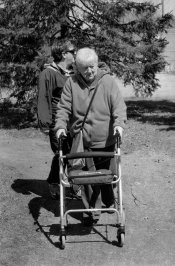I have been working with Thorton's Two Bath Developer (120 roll film on stainless reels) for the past couple of months. I have had excellent luck so far and am settling into an agitation pattern. I have The Edge of Darkness and have done quite a bit of "web" reading on this developer.
I am especially curious about how others are agitating their roll film on stainless reels. This seems to be where the biggest variances occur.
Also, I have been experimenting with Barry's N+ recommendation of a bath B using 20g of Sodium Metaborate instead of the normal 12g. (I have not yet needed an N- that the normal processing didn't handle). When using these variations, are you sticking with your normal agitation or changing that as well?
Thanks for your input.
Firstly, I do not use metal tanks - so this should be taken into consideration - but have exclusively used Barry Thornton's two-bath developer with 120 Delta 400 film for many many years.
The processing sequence that works for me (using Paterson plastic tanks) is as follows:
00:00 pre-soak with constant agitation
01:45 drain pre-soak out of the tank
02:00 Pour Bath A in and invert 4 times in the first 30 seconds followed by a sharp tap on the bottom of the tank to dislodge any possible air bubbles. Then one gentle inversion every 30 seconds always followed by a sharp tap on the bottom of the tank to dislodge any possible air bubbles.
06:45 Pour Bath A out of tank into a jug.
07:00 Pour Bath B in and invert 4 times in the first 30 seconds followed by a sharp tap on the bottom of the tank to dislodge any possible air bubbles. Then one gentle inversion every 30 seconds always followed by a sharp tap on the bottom of the tank to dislodge any possible air bubbles.
11:45 Pour Bath B out of tank into a jug.
12:00 Pour in water stop bath and agitate constantly
12:45 Pour water stop bath out into the drain.
13:00 Pour in fix and agitate constantly
15:00 Remove films from tank and place into a large jug of water and leave until all of the pink dye is removed from the film then return the film to the fix for a further 2 minutes.
Finally, wash using the Ilford method.
A note on mixing the chemicals and use
- I mix up 1 litre of Bath A (my tank is the 1 litre version that can accommodate up to 4 films) and store in a 1 litre dark brown glass bottle. This one litre is sufficient for 24 films (but note the following point about Bath B).
- I mix up two litres of Bath B at the normal 12g of Sodium Metaborate (which are stored in two 1 litre dark brown glass bottles) and use each bottle of Bath B for 12 films and then discard.
- I mix up one litre of Bath B at the N+ dilution of 20g of Sodium Metaborate (which is stored in a 1 litre dark brown glass bottles) and use rarely when needed.
A note on the N-, N and N+ dilutions
- 99% of all my photographs are developed with the N version of Bath B. I have never had any negative where I felt that it should have been developed using the N- version of Bath B.
- The N+ version of Bath B is useful but not in the sense of a strict +1 stop expansion (which can be much better achieved by selenium toning the negative). If I photograph something that has dark shadows and bright highlights but also a significant part of the scene is relatively lacking in mid-tone separation then I use the N+ version of Bath B. This has a significant effect on expanding the mid-tones of a scene that was lacking such a mid-tone separation.
Having just quickly looked through the 100 odd images on my website, there are 6 photographs where I used the N+ Bath B and all of the rest were developed using the normal Bath B.
Best of luck finding your own best way of using Thornton's two-bath developer - it is a great, reliable and cheap developer.
Bests,
David
www.dsallen.de


